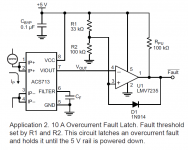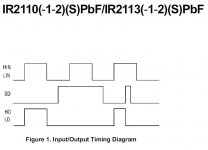Hi,
I need an OCP circuit for a class D. I've been looking at this for a while but I havent been able to find anything.
Thanks!
I need an OCP circuit for a class D. I've been looking at this for a while but I havent been able to find anything.
Thanks!
How much current?
How fast would you like the circuit to react? (or how slow?)
Auto recovery?
What action? Disconnect speaker or reduce/disconnect supply or reduce audio drive?
How fast would you like the circuit to react? (or how slow?)
Auto recovery?
What action? Disconnect speaker or reduce/disconnect supply or reduce audio drive?
Hi, Thanks for your reply.
The amplifier should run at about 2.5Amps at full power, so I'm guessing that the protection should disable both drivers if the current excedes 4Amps.
I'm not sure about the speed of the circuit because I'm new at this so I have no idea how to choose that.
The protection has to shutdown both IR2110 drivers if there is an over current.
The amplifier should run at about 2.5Amps at full power, so I'm guessing that the protection should disable both drivers if the current excedes 4Amps.
I'm not sure about the speed of the circuit because I'm new at this so I have no idea how to choose that.
The protection has to shutdown both IR2110 drivers if there is an over current.
Over current with class D is always a problem due to speed versus stability.
Unlike class B or AB there is no where to turn the drive off if the current exceeds. I would use an amplifier that is capable of your requirements and ensure no short circuits are ever present. Obviously you will have calculated the maximum current your speakers will draw so add a fast acting fuse.
Unlike class B or AB there is no where to turn the drive off if the current exceeds. I would use an amplifier that is capable of your requirements and ensure no short circuits are ever present. Obviously you will have calculated the maximum current your speakers will draw so add a fast acting fuse.
The IR2110 has a shutdown input.
Take that pin high to shut down the driver.
Is this a bridged amplifier or single ended output?
Take that pin high to shut down the driver.
Is this a bridged amplifier or single ended output?
...
Take that pin high to shut down the driver.
...
I was also thinking of a cct like mikemb suggested.
If you sense in the speaker line you would need two to them and some type of OR function such that either polarity of over current would shut down the IR2110.
If you sense in the power supply line then only one cct is required.
Attachments
Hi all.
First post.
I like the ciruit Mikemb shows. Just a few things to note: Be careful where you put this circuit. Since it's a Hall effect sensor measuring the current it will be sensitive to ANY magnetic field that is on the same axis as the internal wire between IP+ and IP-. Speaker magnets, inductor filters, and stray wires with high current are the worst offenders.
Since you're only wanting to limit to about 4 amps, you may want to consider the ACS712 at 5 amps. Vout will be 2.5V +/- 185 mV/amp. Thus, if you have +2.5 amps, Vout will be 2.96 volts. 4amps will give you 3.24 volts.
If you're measuring the speaker line (ignoring DC) I would use a current transformer into a full wave rectifier, then into the comparitor.
Hope this helps.
Tina
First post.
I like the ciruit Mikemb shows. Just a few things to note: Be careful where you put this circuit. Since it's a Hall effect sensor measuring the current it will be sensitive to ANY magnetic field that is on the same axis as the internal wire between IP+ and IP-. Speaker magnets, inductor filters, and stray wires with high current are the worst offenders.
Since you're only wanting to limit to about 4 amps, you may want to consider the ACS712 at 5 amps. Vout will be 2.5V +/- 185 mV/amp. Thus, if you have +2.5 amps, Vout will be 2.96 volts. 4amps will give you 3.24 volts.
If you're measuring the speaker line (ignoring DC) I would use a current transformer into a full wave rectifier, then into the comparitor.
Hope this helps.
Tina
- Status
- Not open for further replies.
- Home
- Amplifiers
- Class D
- Need Over Current Protection Circuit for Class D

